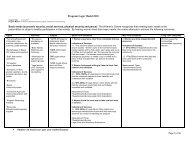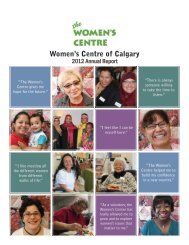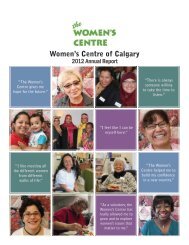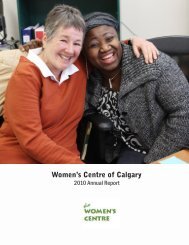Fast Facts - Women's Centre of Calgary
Fast Facts - Women's Centre of Calgary
Fast Facts - Women's Centre of Calgary
- No tags were found...
Create successful ePaper yourself
Turn your PDF publications into a flip-book with our unique Google optimized e-Paper software.
<strong>Fast</strong><strong>Facts</strong>onWOMEN AND POVERTYFact - You’re morelikely to be poor ifyou’re a woman.FACTWomen still assume most<strong>of</strong> the responsibility forchildren and aging family.This means that morewomen work part-time,which has a life-longeffect on their income.Women <strong>of</strong>ten remain inabusive relationships toavoid poverty andhomelessness.FACTIn Canada,64% <strong>of</strong> families headedby single motherslive in poverty.Studies show that thepoverty rates <strong>of</strong> womenand their families wouldfall if mothers had accessto universal child care.FACTIn Canada:35% <strong>of</strong> single womenunder 65 live in poverty.41.5% <strong>of</strong> single,widowed, or divorcedwomen over 65 live inpoverty.37% <strong>of</strong> women <strong>of</strong>colour are low income.Any woman, any age,any question.646 – First Ave NE <strong>Calgary</strong>phone (403) 264-1155www.womens-centre.org
A safe place for women to• Get Assistance• Connect With Others• Create ChangeFREE AND CONFIDENTIALFACTAlberta has thelargest pay gap inCanada. Women earn66% <strong>of</strong> what men earnfor full-time, full-yearjobs.In Alberta, 2/3 <strong>of</strong>minimum wage earnersare women.FACTIn Canada,44% <strong>of</strong> Aboriginalwomen living <strong>of</strong>f reserve,and 47% <strong>of</strong> Aboriginalwomen living on reservelive in poverty.In Alberta, Aboriginalwomen earn 50% lessthan the overall averageincome.FACTAlberta has the 2ndlowest social assistancerates for lone-parentfamilies in Canada. In2009, the welfare incomefor a lone parent with onechild was still 30% belowthe low income cut-<strong>of</strong>f(LICO).Alberta is the onlyprovince that does notexamine social andeconomic policy for impacton women and children.The statistics presented areaverages. Women who areadditionally marginalized bytheir age, race, ethnicity, ability,and immigration status areeven more at risk <strong>of</strong> living inpoverty.We must continue to advocatefor policies and services thatrecognize the impact <strong>of</strong>poverty on women, children,and society. What will YOU doto change the numbers?Source <strong>of</strong> Statistics:Statistics Canada, Parkland Institute,CRIAW, ACSW, ACWS, NationalCouncil <strong>of</strong> Welfare









